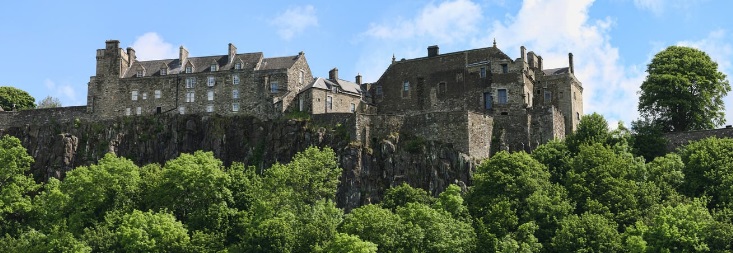Stirling Castle
Perched dramatically atop Castle Hill, overlooking the River Forth and the city of Stirling, Stirling Castle stands as one of Scotland’s most significant and spectacular historic landmarks. Its commanding position, rich royal heritage, and architectural grandeur make it not just a fortress, but a symbol of Scotland’s national identity. For centuries, Stirling Castle has been at the heart of the nation’s story — a witness to battles, coronations, and the lives of monarchs who shaped the country’s destiny.
A Fortress of Strategic Importance
Stirling Castle’s location has always been of immense strategic value. It sits on a volcanic crag that dominates the landscape and guards the main crossing point of the River Forth — historically known as the “Gateway to the Highlands.” Whoever controlled Stirling controlled the route between the Scottish Lowlands and Highlands, making the castle a key military stronghold for centuries.
Because of this, the castle has seen its share of conflict. It was besieged and fought over many times during the Wars of Scottish Independence. Notably, the nearby Battle of Stirling Bridge (1297), where William Wallace and Andrew Moray famously defeated English forces, and the Battle of Bannockburn (1314), where Robert the Bruce secured a decisive victory, both underscored the castle’s immense strategic and symbolic value.

A Royal Residence and Renaissance Jewel
While its military importance is undeniable, Stirling Castle was also one of Scotland’s grandest royal residences. From the 15th to the 17th centuries, it was a favourite home of the Stewart monarchs, who transformed it into a palace of splendour and ceremony. Kings and queens, including James IV, James V, and Mary, Queen of Scots, left their mark on the castle, commissioning magnificent buildings and hosting lavish events within its walls.
The Royal Palace, built during the reign of James V, is one of the finest examples of Renaissance architecture in the British Isles. Its elegant façades, ornate carvings, and grand halls were designed to showcase Scotland’s sophistication and to impress foreign ambassadors. Inside, the Great Hall — the largest of its kind ever built in medieval Scotland — hosted feasts, courtly entertainments, and royal ceremonies. The Chapel Royal, constructed by James VI in 1594 for the baptism of his son, Prince Henry, remains one of the last great royal buildings added to the castle.
Mary, Queen of Scots and the Castle’s Royal Legacy
Few figures are as closely associated with Stirling Castle as Mary, Queen of Scots. She was crowned here as an infant in 1543, and the castle served as her childhood home. Later monarchs also maintained deep ties to the site, including James VI, who was educated at Stirling before becoming James I of England and uniting the crowns in 1603.
Over the centuries, the castle evolved from royal residence to military fortress once again. It played roles in later conflicts, including the Jacobite Risings of the 18th century, and later became an army barracks. Today, it stands as both a symbol of national pride and a meticulously preserved historic treasure.
Architecture and Artistry
The castle’s buildings reflect a rich blend of medieval fortification and Renaissance artistry. Visitors can explore the Outer Defences, with their formidable gates and bastions, or the Inner Close, where the Royal Palace, Great Hall, and Chapel Royal are arranged around a grand courtyard. Inside, the Stirling Heads Gallery displays beautifully restored oak medallions featuring carved portraits of kings, queens, and mythological figures — masterpieces of 16th-century craftsmanship.
The Great Kitchens, restored to show how royal feasts were prepared, and the Tapestry Studio, which recreated the stunning “Hunt of the Unicorn” tapestries, offer glimpses into courtly life and artistry. Every detail — from the painted ceilings to the heraldic symbols — tells a story of power, prestige, and Scotland’s Renaissance ambitions.
A Living Monument and Cultural Landmark
Today, Stirling Castle is managed by Historic Environment Scotland and welcomes hundreds of thousands of visitors each year. It offers immersive exhibitions, guided tours, and re-enactments that bring Scotland’s royal history vividly to life. From its battlements, visitors can gaze across the Forth Valley — to the Wallace Monument, Bannockburn battlefield, and the distant Trossachs hills — and understand why this spot was so vital to Scotland’s past.
Conclusion
Stirling Castle is more than a monument — it is the beating heart of Scottish history. Its stones echo with the footsteps of warriors, kings, and queens who shaped a nation. Blending breathtaking architecture, dramatic landscapes, and centuries of legend, Stirling Castle remains one of Scotland’s most awe-inspiring and meaningful sites. To stand within its walls is to stand where Scotland’s destiny was forged.
